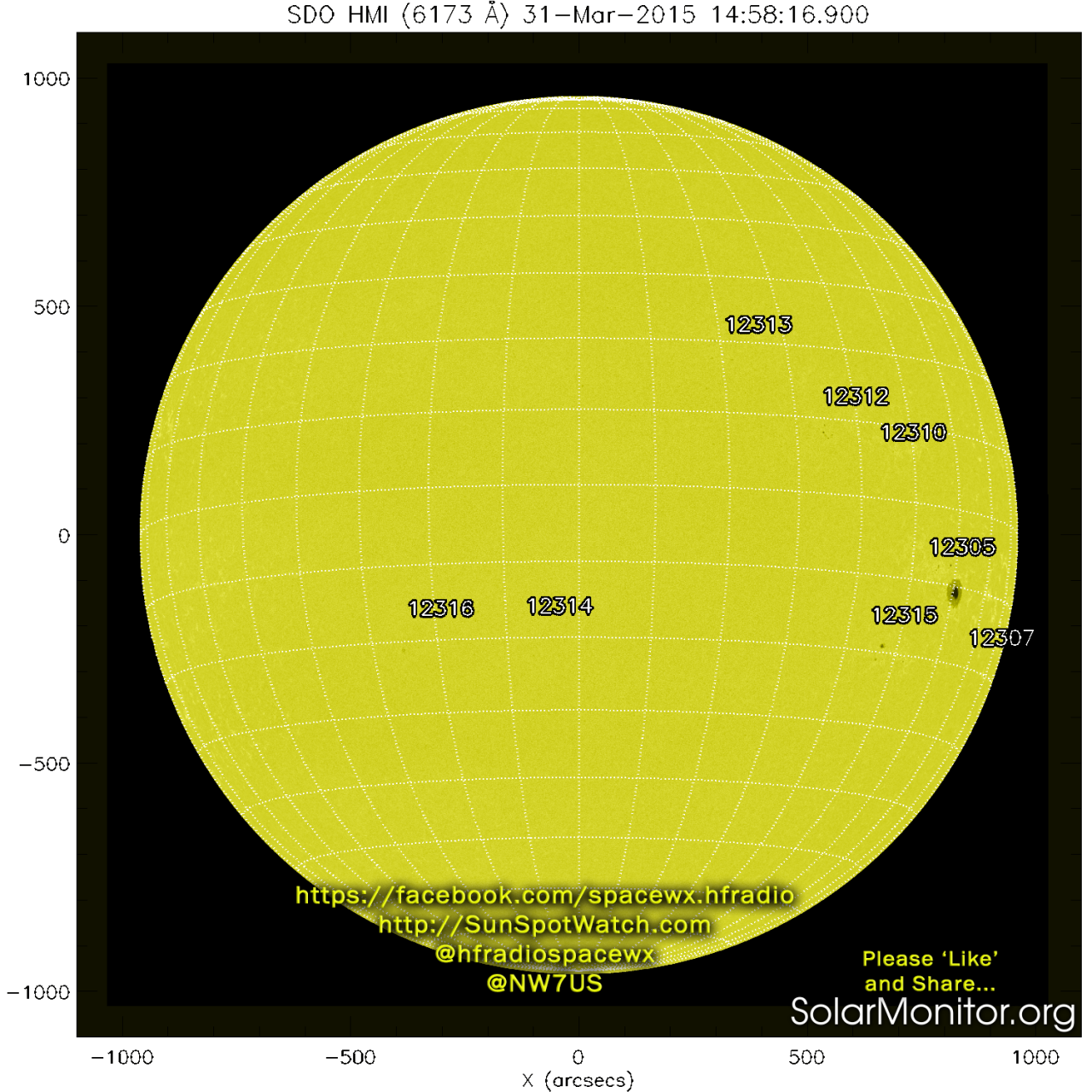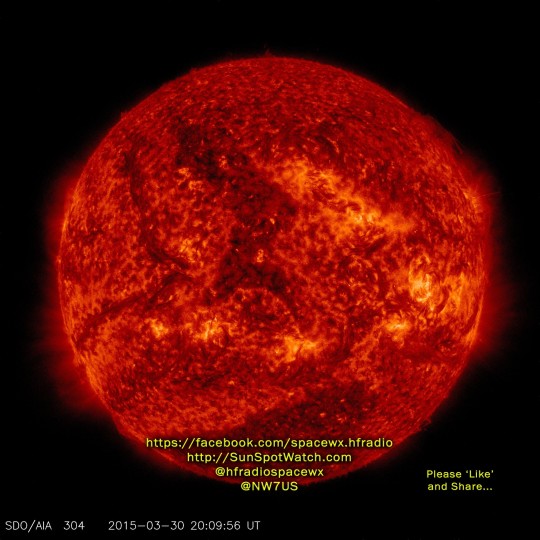Author Archive
 Today’s Solar and Geophysical Activity (2015 Mar 31 18:30 UTC)
Today’s Solar and Geophysical Activity (2015 Mar 31 18:30 UTC)
Daily solar report: Current Sunspot Cycle 24 Activity and Space Weather
Sunspot count: Sun Spots: 56 as of 03/30/2015
10.7-cm Radio Flux: 134 SFU (SFU=Solar Flux Units)
Estimated Planetary A-index (Ap): 5 | K-index (Kp): 2
Solar Wind: 405 km/s at 16.0 protons/cm3, Bz is 2.0 nT
(Mar 31, 2015 at 1820 UT)
X-ray Solar Flares:
6h hi [C4.7][0138Z 03/30] 24h hi [C4.7][0138Z 03/30]
Background X-ray Level, Last Six Days
Mar 30 2015 :: B6.6
Mar 29 2015 :: B9.1
Mar 28 2015 :: B7.9
Mar 27 2015 :: B5.0
Mar 26 2015 :: B4.5
Mar 25 2015 :: B5.4
Global HF Propagation Conditions for 1800Z on 31 Mar, 2015
High Latitude: Fair
Middle Latitude: Normal
Low Latitude: Normal
Geomagnetic Latitude Ranges: High: 60-90 degrees, Middle: 20-60 degrees, Low: 0-20 degrees
For live data and images, visit http://SunSpotWatch.com
Get the space weather and radio propagation self-study course, today. Visit http://nw7us.us/swc for the latest sale and for more information!
This report has been prepared by your space weather and radio propagation reporter, Tomas ( amateur radio operator, NW7US, http://NW7US.us )
We’re on Facebook: http://NW7US.us/swhfr
 Today’s Plot-Graph of Solar, Ionospheric, and Geomagnetic Indices (31 March 2015)
Today’s Plot-Graph of Solar, Ionospheric, and Geomagnetic Indices (31 March 2015)
Today’s graph, plotting the SESC sunspot number, the 10.7cm Radio Flux, and the Estimated Planetary A Index, for the last 30 days.
The numbers are:
Date | Sunspots | 10.7-cm Flux | Ap
==========================================
2015/03/30 | 56 | 134 | 5
2015/03/29 | 73 | 145 | 14
2015/03/28 | 82 | 146 | 9
2015/03/27 | 109 | 138 | 9
2015/03/26 | 103 | 136 | 8
2015/03/25 | 115 | 138 | 13
2015/03/24 | 127 | 133 | 12
2015/03/23 | 119 | 128 | 21
2015/03/22 | 88 | 122 | 24
2015/03/21 | 40 | 114 | 14
2015/03/20 | 27 | 113 | 24
2015/03/19 | 71 | 109 | 28
2015/03/18 | 44 | 115 | 52
2015/03/17 | 60 | 114 | 117
2015/03/16 | 57 | 117 | 11
2015/03/12 | 56 | 127 | 8
2015/03/11 | 42 | 132 | 9
2015/03/10 | 42 | 121 | 5
2015/03/09 | 29 | 123 | 6
2015/03/08 | 23 | 124 | 11
2015/03/07 | 20 | 138 | 20
2015/03/06 | 37 | 127 | 13
2015/03/05 | 31 | 130 | 6
2015/03/04 | 43 | 124 | 10
2015/03/03 | 38 | 125 | 11
2015/03/02 | 65 | 130 | 28
For complete live data and images visit http://SunSpotWatch.com
Be sure to share this post, to spread the love!
We’re on Facebook: http://NW7US.us/swhfr
 Today’s Sun Seen at the 304-Angstrom Wavelength (30 March 2015)
Today’s Sun Seen at the 304-Angstrom Wavelength (30 March 2015)
Today’s Sun (artificially-colored in red) seen at the 304-angstrom wavelength (Extreme Ultraviolet, or EUV), as viewed by the Solar Dynamics Observatory (SDO), by the Atmospheric Imaging Assembly (AIA).
At this wavelength, at a wavelength not seen by the un-aided eye, we can see the Sun through the 30.4 nm (304 A) filter. This Extreme Ultraviolet (EUV) waveband is used to monitor the chromosphere and lower transition region. It is useful to see plasma and filament activity, including filamet eruptions and coronal mass ejections (CMEs).
The image is a “false color image”, meaning that observed data are in a range outside of what human eyes can see, so the data are digitally recast into colors that emphasize physically important features. This view is created from data gathered by the Solar Dynamics Observatory (SDO) satellite that flies above Earth”s atmosphere in an inclined geosynchronous orbit.
Emissions captured in this image come from helium (He), the second most abundant element in the solar atmosphere. Singly ionized Helium (He II) emits Extreme Ultraviolet (EUV) light when heated to temperatures of ~70,000 deg K. In the upper solar atmosphere the temperatures are so high that most chemical elements have lost many of their electrons. The remaining electron, which is still attached to the atom, emits EUV radiation in narrow wavebands or lines when it is in an excited state.
The 30.4 nm filter (also called channel or bandpass) is dominated by emissions from singly (once) ionized helium which has missing 1 electron–He II. The roman numeral descriptor is consistent with spectral notation: the level of ionization for a given roman numeral is one unit larger that the actual number of missing electrons. The temperatures associated with this level of ionization is range from 6 x 10^4 K to 8 x 10^4 K.
The bright regions in this image correspond to regions of closed magnetic field loops that trap the hot, emitting plasma. Large bright regions are often called active regions. The dark regions correspond to cooler temperatures and possibly to locations where magnetic field lines open into the heliosphere, and thus, do not trap hot plasma.
View live data and images at http://SunSpotWatch.com
Get the space weather and radio propagation self-study course, today. Visit http://nw7us.us/swc for the latest sale and for more information!
We”re on Facebook: http://NW7US.us/swhfr
 January Special Event – Straight Key Century Club and K3Y/0
January Special Event – Straight Key Century Club and K3Y/0
All month long, during January 2015, a group of volunteers using the special event callsign, “K3Y” with a slant-region number (i.e., “K3Y/3” or “K3Y/0”), were on the amateur radio HF bands (and some, on six meters). I was one of these volunteers, operating nearly every day of the month for at least one hour, but some times a few hours per day.
“K3Y,” the Straight Key Century Club’s annual January celebration, commemorates the club’s founding in 2006 following the American Radio Relay League’s Straight Key Night. A small group of participants wanted to extend the fun of SKN throughout the year. The SKCC is the result.
For the first three years, the club’s founders used K1Y, K2A, and K3Y as the celebration’s special-event calls. But someone cleverly noticed that a 3 is nothing more than a backwards, curvaceous E. This “KEY” event has operated under the K3Y call ever since.
The on-air party is open to members and non-members alike. It runs from 0000 UTC Jan. 2 through 2359 UTC Jan. 31. It’s a great time to introduce others to the joys of hand-crafted Morse code using straight keys, bugs, and side swipers.
In this video, you can see this operation at my ham radio shack, as I am the control operator of the special event station, “K3Y/0”, during one of the many shifts. “K3Y” is the special event callsign of the Straight Key Century Club (SKCC). The special event operates each January.
In the following video, you can see some of the QSL cards associated with this year’s operation, and then some other QSL cards in my collection.
https://www.youtube.com/watch?v=gOsNjT7OCyc
+ The SKCC website is at http://skccgroup.com
+ The “K3Y” special event page is http://www.skccgroup.com/k3y/index.php
+ My page is at http://NW7US.us
+ My Morse code page is http://cw.hfradio.org
 Celebration of SKCC – K3Y Special Event
Celebration of SKCC – K3Y Special Event
Special event, “K3Y,” the Straight Key Century Club’s annual January celebration, commemorates the Straight Key Century Club’s founding in 2006 following the American Radio Relay League’s “Straight Key Night” (SKN). A small group of participants wanted to extend the fun of SKN throughout the year. The Straight Key Century Club (SKCC) is the result.
For the first three years, the club’s founders used the special event callsigns of K1Y, K2A, and K3Y as the celebration’s special-event calls. But, someone cleverly noticed that a ‘3’ is nothing more than a backwards, curvaceous ‘E’. This “KEY” event has operated under the special event callsign of ‘K3Y’, ever since.
The on-air party is open to members and non-members alike. It runs from 0000 UTC Jan. 2 through 2359 UTC Jan. 31. It’s a great time to introduce others to the joys of hand-crafted Morse code using straight keys, bugs, and side swipers.
In this video, you can “sit in” with NW7US, the control operator of the regional activation of special event station, “K3Y/0”, during one of the many shifts during January (2015).
+ The SKCC website is at http://skccgroup.com
+ The K3Y special event page is http://www.skccgroup.com/k3y/index.php
+ The NW7US website is at http://NW7US.us
+ Some more CW/Morse code resources can be found at http://cw.hfradio.org
 Largest Sunspot Region (so far) in Sunspot Cycle 24
Largest Sunspot Region (so far) in Sunspot Cycle 24
Look at this huge sunspot, the largest yet of Sunspot Cycle 24! It is about the same diameter as Jupiter! Notice how tiny Earth is, in comparison. Sunspots are regions on the Sun’s photosphere, formed by the “convection” of solar plasma deep inside the Sun, causing the twisting and shifting of magnetic fields. They look like spots on the photosphere because they are cooler than their surrounding solar material, giving them their dark, blemish-like appearance.
The sunspot is the largest since November 1990, and is larger than a monster sunspot that spawned a series of major solar flares over Halloween in 2003. AR 2192 was one of the biggest observed sunspots of all time, ranking 33rd largest of 32,908 active regions since 1874, according to NASA scientists C. Alex Young and Dean Pesnell.
Interestingly, this sunspot never released any major coronal mass ejection (CME), because the magnetic fields were too strong to let any significant plasma escape! However, this sunspot group unleashed a fair number of moderate to strong x-ray flares (see one of them in this video at < http://g.nw7us.us/1s7L0vF >). All told, AR 2192 popped off 26 M-class flares, and six X-class flares! Of course, during the last sunspot cycle, Cycle 23, there were many active sunspot regions unleashing flare after flare within hours of each other. That’s typical during the active phase of most sunspot cycles. This cycle, however, is one of the weakest on record, so this large sunspot with its many flares is exciting.
Each sunspot region gets a consecutive number assigned to it by the National Oceanic and Atmospheric Administration (NOAA). This sunspot region is NOAA AR (active region) Nr. 12192 (we often drop the first digit when speaking of a sunspot, so in this case, this region was often referred to as AR 2192).

One of the many x-ray flares originating from Active sunspot Region AR 2192 – this one seen in Extreme Ultraviolet at 131 Angstroms.
This sunspot region increased the ionization of the ionosphere, creating excellent conditions on all of the high frequency spectrum (shortwave, or HF). Even ten meters was alive with world-wide propagation. And, the best news is that this provided an exciting playing field for the CQ WW SSB contest in late October, 2014.
This sunspot region has now rotated away, but may return on about 24 days.
Credit: NASA/SDO/HMI
Check out: http://SunSpotWatch.com
Get the space weather and radio propagation self-study course: http://NW7US.us/swc
 Check out the sunspots!
Check out the sunspots!
Just before the 4th of July, several sunspot regions rotated into view. Today, they are significant players in elevating the solar output of Extreme Ultraviolet energy — the energy helpful in ionizing the F-region of our Earth’s ionosphere. That, in turn, means better propagation conditions, even on higher shortwave frequencies.

As seen by the Solar Dynamics Observatory, the Sun is sporting quite a few sunspots, today. These are helping elevate the 10.7-cm flux, which is a proxy for solar output that strengthens the ionospheric propagation of higher frequencies in the shortwave spectrum. Expect good conditions on HF, this weekend.
73 and best DX!

















